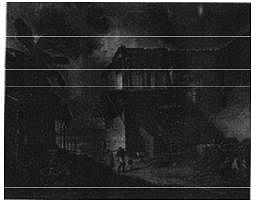Humanities/Arts Exam > Humanities/Arts Questions > The painting given here was painted by George...
Start Learning for Free
The painting given here was painted by George Chinnery in 1820. This painting depicted :

- a)Bengal village scene
- b)A south Indian village
- c)The plight of ryots
- d)A mahal (estate )
Correct answer is option 'A'. Can you explain this answer?
Most Upvoted Answer
The painting given here was painted by George Chinnery in 1820. This p...
Bengal village scene, paint ed by George Chinnery, 1820 Chinnery stayed in India for 23 years (1802-25), painting portraits, landscapes and scenes of the everyday life of the common people.

|
Explore Courses for Humanities/Arts exam
|

|
Similar Humanities/Arts Doubts
The painting given here was painted by George Chinnery in 1820. This painting depicted :a)Bengal village sceneb)A south Indian villagec)The plight of ryotsd)A mahal (estate )Correct answer is option 'A'. Can you explain this answer?
Question Description
The painting given here was painted by George Chinnery in 1820. This painting depicted :a)Bengal village sceneb)A south Indian villagec)The plight of ryotsd)A mahal (estate )Correct answer is option 'A'. Can you explain this answer? for Humanities/Arts 2025 is part of Humanities/Arts preparation. The Question and answers have been prepared according to the Humanities/Arts exam syllabus. Information about The painting given here was painted by George Chinnery in 1820. This painting depicted :a)Bengal village sceneb)A south Indian villagec)The plight of ryotsd)A mahal (estate )Correct answer is option 'A'. Can you explain this answer? covers all topics & solutions for Humanities/Arts 2025 Exam. Find important definitions, questions, meanings, examples, exercises and tests below for The painting given here was painted by George Chinnery in 1820. This painting depicted :a)Bengal village sceneb)A south Indian villagec)The plight of ryotsd)A mahal (estate )Correct answer is option 'A'. Can you explain this answer?.
The painting given here was painted by George Chinnery in 1820. This painting depicted :a)Bengal village sceneb)A south Indian villagec)The plight of ryotsd)A mahal (estate )Correct answer is option 'A'. Can you explain this answer? for Humanities/Arts 2025 is part of Humanities/Arts preparation. The Question and answers have been prepared according to the Humanities/Arts exam syllabus. Information about The painting given here was painted by George Chinnery in 1820. This painting depicted :a)Bengal village sceneb)A south Indian villagec)The plight of ryotsd)A mahal (estate )Correct answer is option 'A'. Can you explain this answer? covers all topics & solutions for Humanities/Arts 2025 Exam. Find important definitions, questions, meanings, examples, exercises and tests below for The painting given here was painted by George Chinnery in 1820. This painting depicted :a)Bengal village sceneb)A south Indian villagec)The plight of ryotsd)A mahal (estate )Correct answer is option 'A'. Can you explain this answer?.
Solutions for The painting given here was painted by George Chinnery in 1820. This painting depicted :a)Bengal village sceneb)A south Indian villagec)The plight of ryotsd)A mahal (estate )Correct answer is option 'A'. Can you explain this answer? in English & in Hindi are available as part of our courses for Humanities/Arts.
Download more important topics, notes, lectures and mock test series for Humanities/Arts Exam by signing up for free.
Here you can find the meaning of The painting given here was painted by George Chinnery in 1820. This painting depicted :a)Bengal village sceneb)A south Indian villagec)The plight of ryotsd)A mahal (estate )Correct answer is option 'A'. Can you explain this answer? defined & explained in the simplest way possible. Besides giving the explanation of
The painting given here was painted by George Chinnery in 1820. This painting depicted :a)Bengal village sceneb)A south Indian villagec)The plight of ryotsd)A mahal (estate )Correct answer is option 'A'. Can you explain this answer?, a detailed solution for The painting given here was painted by George Chinnery in 1820. This painting depicted :a)Bengal village sceneb)A south Indian villagec)The plight of ryotsd)A mahal (estate )Correct answer is option 'A'. Can you explain this answer? has been provided alongside types of The painting given here was painted by George Chinnery in 1820. This painting depicted :a)Bengal village sceneb)A south Indian villagec)The plight of ryotsd)A mahal (estate )Correct answer is option 'A'. Can you explain this answer? theory, EduRev gives you an
ample number of questions to practice The painting given here was painted by George Chinnery in 1820. This painting depicted :a)Bengal village sceneb)A south Indian villagec)The plight of ryotsd)A mahal (estate )Correct answer is option 'A'. Can you explain this answer? tests, examples and also practice Humanities/Arts tests.

|
Explore Courses for Humanities/Arts exam
|

|
Signup for Free!
Signup to see your scores go up within 7 days! Learn & Practice with 1000+ FREE Notes, Videos & Tests.
























